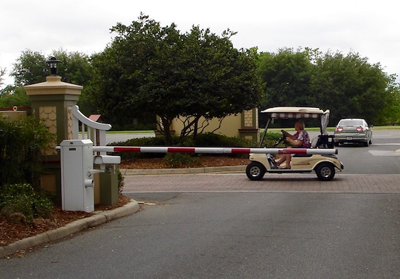Autonomous Transportation Inches into Gated Communities
A recent article in the New York Times featured the introduction of a driverless automobile in a gated community in California. The community, located near San Jose and called, The Villages Golf and Country Club, has a significant constituency of seniors, the average age of residents being 78.
This is a community where golf cars, outfitted and customized as personal transportation vehicles (PTVs), play a major role in providing necessary mobility within the general property. On the other hand, it is, as are most gated communities, a mixed environment with regard to vehicle use. Most residents have both a PTV and a conventional, on-road automobile. This mixed transportation environment presents certain challenges when it comes to self-driving vehicles.
Traffic Challenges in the Gated Community
One of those challenges is, aside from avoiding accidents with pedestrians, is dodging aggressively driven PTVs. My own experience in a visit to a Florida community bears this out. When I attend the annual PGA Show in Florida, I like to drive around to dealers and gated communities to gather data and get impressions of trends in the market. In one such foray, I drove up from Orlando to The Villages, the sprawling community close to Ocala that is a city unto itself. The rented vehicle I was driving was a Ford Fusion—not really a large vehicle, but a good deal heftier than the typical PTV. Nonetheless, I learned quickly that within The Villages the “little guy” is king. If at an intersection there is even the slightest doubt as who has the rightaway, you, as the driver of a conventional vehicle, should gracefully cede the turf to the smaller fella. Why? Because he (or she) is going claim the rightaway, regardless of the merits of the situation. It’s kind of “collision-avoidance 101.”
So, I can appreciate the challenges for a self-driving, autonomous vehicle; that is, in teaching it, via its sensory system and software guidance, the rules of the road in a gated community.
Which Should Be Automated, the PTV, or the Conventional Vehicle?
Much of the intense interest with regard to autonomous vehicles focuses on an adaptation to conventional, on-road vehicles. This is certainly understandable since that is where the volume of sales is likely to be. Quite possibly with that in mind the company that engaged the residents and management of The Villages (San Jose, not Florida) outfitted a Ford Fusion with their autonomous technology and set about testing it in the confines of the property.
The company involved is Voyage, a start-up in true Silicon Valley tradition, and, in particular, headed by Sebastian Thrun. Mr. Thrun is notable for being the founder of Google’s driverless car project. His name and reputation as an innovator is doubtless why the company was able to raise funds to commence operations.
But why automate the on-road vehicle, rather than the PTV? One could make the argument that an enclosed PTV would be the ideal candidate for driverless technology, as the driver/owner would have no competition, so to speak, in accessing the vehicle as needed. The answer is, of course, cost. While the cost of sensory systems for driverless vehicles are experiencing dramatic decreases, we are still talking an expenditure of $5,000 to $7,500 and possibly more per unit. In addition, there is still the question of dependability and effectiveness, because such systems have yet to rack up thousands of miles of actual, all conditions operation. Thus, the economics of investment in autonomous vehicle technology runs this way: The initial stage is concept and prototype development. The second stage is aiming for the volume market via collaborations with automakers. The next stage is actual commercialization in the volume market, resulting in (hopefully) dramatic declines in unit cost as production ramps up. Finally, the spin-offs to other markets take hold, one of those being the market for PTVs.
Ford Sees Big Cost Drops in Velodyne Collaboration
The news at around the time of the recent Detroit Auto Show was Ford’s forecast that its collaboration with sensory system provider Velodyne would see the latter’s Puck™ product drop in price to $500, possibly by 2020. Not only is the price likely to decline significantly (the original Velodyne self-driving apparatus cost $75,000), but the process of miniaturization is well underway as the photo below indicates.
With a price in the $500 range, it is quite possible to see PTVs outfitted with autonomous vehicle technology in the not-so-distant future.
Wake-Up Call for Gated Community Managements and Investors
Given that many, if not most, gated and planned communities have residents with age-related handicaps with respect to mobility, accommodation for self-driving vehicles could well become a selling point for the property. Combined with the need for more comprehensive and advanced charging systems (see my previous column on Level 2 fast charging), investors in new or upgraded gated communities will be looking to these technologies as a modern convenience and necessary infrastructure component of the gated community.
Contact the Author: Steve Metzger at smetzger@smallvehicleresource.com. Or check out our website at www.smallvehicleresource.com, where you will find an extensive database of vehicle models and can make side-by-side comparisons of vehicles based on a full set of specifications.



